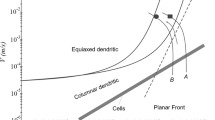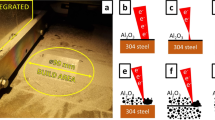Abstract
Gas-atomized metallic powders are commonly used in additive manufacturing processes. Research has shown that, for certain AM techniques, the chemistry and microstructural properties of the feedstock powders significantly affect the properties of the consolidated material. Understanding the powder characteristics before use in additive manufacturing can lead to optimizing properties of additively manufactured materials as well as determining the recyclability of feedstock powders. This research studies the effect of various solution treatment processes on the characteristics and microstructural evolution of powder aluminum alloy 6061. Solution treatment times and temperatures were guided by thermodynamic and kinetic modeling. Light microscopy, scanning electron microscopy, and hardness were used to evaluate each condition in both two and three dimensions. Results indicate that the Mg2Si present in the untreated condition dissolves after 60 min of solution treatment, while there are competing effects from the dissolution and concurrent growth of various Fe-containing phases. Additionally, it is shown that both granular and sub-granular structures exist in these rapidly solidified powders, and the sub-grains reorient themselves during solution treatment.









Similar content being viewed by others
References
L. Katgerman and D. Eskin, Hardening, Annealing and Aging, Handbook of Aluminum Volume 1: Physical Metallurgy and Processes, 1st ed., G.E. Totten and D.S. MacKenzie, Ed., Taylor & Francis Group, Routledge, 2003, p 277–280
D. Belsito, B. McNally, L. Bassett, R. Sisson Jr., and V. Champagne, A through-process model for cold sprayed aluminum alloys, in Thermal Process Modeling 2014: Proceedings from the Fifth International Conference on Thermal Process Modeling and Computer Simulation, June 16-18 2014 (Orlando, FL), ASM International, p 308
C. Walde, in Feedstock Powder Analysis for Additive Manufacturing Applications, AeroMat Conference and Exposition, April 10-12 2017 (Charleston, SC), ASM
R. DeHoff, Quantitative Serial Sectioning Analysis: Preview, J. Microsc., 1983, 131(3), p 259–263
M. Yanuka, F. Dullien, and D. Elrick, Serial Sectioning and Digitization of Porous Media for Two- and Three-Dimensional Analysis and Reconstruction, J. Microsc., 1984, 135(2), p 159–168
J. Spowart, Automated Serial Sectioning for 3-D Analysis of Microstructures, Scripta Mater., 2006, 55(1), p 5–10
A. Zankel, J. Wagner, and P. Poelt, Serial Sectioning Methods for 3D Investigations in Materials Science, Micron, 2014, 62, p 66–78
T. Burnett, R. Kelley, B. Winiarski, L. Contreras, M. Daly, A. Gholinia, M. Burke, and P. Withers, Large Volume Serial Section Tomography by Xe Plasma FIB Dual Beam Microscopy, Ultramicroscopy, 2016, 161, p 119–129
V. Champagne, A. Nardi, and D. Cote, Materials Characterization of Advanced Cold-Spray Aluminum Alloys, Int. J. Powder Metall., 2015, 51(4), p 19
S. Singh, J. Loza, A. Merkle, and N. Chawla, Three Dimensional Microstructural Characterization of Nanoscale Precipitates in AA7075-T651 by Focused Ion Beam (FIB) Tomography, Mater. Charact., 2016, 118, p 102–111
R. Abassi, K. Dzieciol, and A. Borbély, Three-Dimensional Analysis of Creep Voids in Copper by Serial Sectioning Combined with Large Field EBSD, Mater. Sci. Technol., 2015, 31(5), p 540–546
ASTM E11-17 Standard Specification for Woven Wire Test Sieve Cloth and Test Sieves. ASTM International, West Conshohocken, PA, 2017
ASTM B209-14 Standard Specification for Aluminum and Aluminum-Alloy Sheet and Plate. ASTM International, West Conshohocken, PA, 2014
Acknowledgments
This work was funded by the United States Army Research Laboratory, Grant #W911NF-15-2-0024. This work was performed in part at the University of Connecticut Institute of Materials Science (UCONN IMS).
Author information
Authors and Affiliations
Corresponding author
Additional information
This article is an invited paper selected from presentations at the symposium “Additive Manufacturing of Metals: Powder Feedstock Characterization and Performance Simulation,” held during MS&T’17, October 8-12, 2017, in Pittsburgh, Pa., and has been expanded from the original presentation.
Electronic supplementary material
Below is the link to the electronic supplementary material.
Rights and permissions
About this article
Cite this article
Walde, C., Cote, D., Champagne, V. et al. Characterizing the Effect of Thermal Processing on Feedstock Al Alloy Powder for Additive Manufacturing Applications. J. of Materi Eng and Perform 28, 601–610 (2019). https://doi.org/10.1007/s11665-018-3550-0
Received:
Revised:
Published:
Issue Date:
DOI: https://doi.org/10.1007/s11665-018-3550-0




